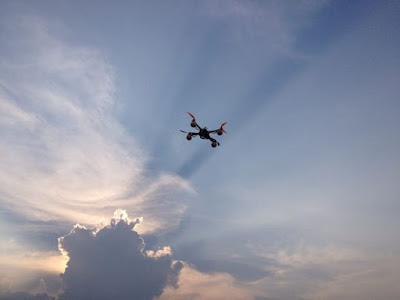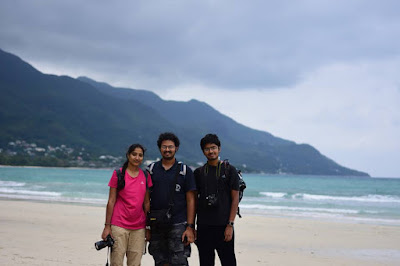 |
| The HAL Tejas showing off its double delta wing. |
Ever since the first Aero India, seeing it live was always in the plans. After moving to Bangalore in 2010, I missed the Aero Indias of 2011 and 2013 due to one reason or another at IISc. I missed Aero India 2015 due to a lack of leaves at MathWorks ( I was saving them up for the epic transcontinental train ride the following month). I was finally able to attend Aero India 2017. Srivani couldn't make it as she had some important classes at college. My colleague, Praveen, from Gwynniebee came along with me. Aero India grew from a small exposition of Indian aircraft 20 years ago to a mega event that rivals the likes of MAKS or Farnborough. This time, there were two demonstration teams from India and two from abroad. This was the first demo by Team Yakovlevs in India. The MMRCA contestants came to demonstrate and pitch as well. They included the F-16I from the US, Dassault Rafale from France and Saab Gripen from Sweden.
 |
| The DRDO Netra AEW&C based on the E-145. |
 |
| Mil Mi-17V5. |
 |
| HAL Tejas taking off with afterburner. |
Yelahanka AFB is not new to me. I've peered across its compound wall many a times. It was a favourite pastime from IISc and is a sweet 17 km bicycle ride away from IISc. This base houses squadrons of Dornier Do-228s, Mil Mi-17s, Antonov An-32s and Hs.748s. This is also the headquarters of the transport training command and was the point of origin for Jaffna airdrop of Operation Poomalai during 1987. The landing glideslope stretches across the NH-7, which is at its boundary. Sitting on the shoulder of NH-7, one can get amazing views of large transports as they perform their final approaches. I reached the venue on my Vespa, reaching well within time for the 11AM-12PM time slot. The parking, security and other logistics were very well taken care off. Praveen came on his own bike and we synced up at the base. We had booked tickets only for the flying display and not for the static display, which was open only on the Sunday and we correctly assumed that it'd be crowded.
 |
| Condensation on the Sukhoi Su-30MKI. |
 |
| Team Yakovlevs. |
 |
| The Sarang display team. |
When we arrived we saw a Mil Mi-17V5 arriving for landing. It was perhaps not a part of the flying display and probably a security detail. The first flypast was that of the E-145 based AEW&C aircraft developed by DRDO, called the Netra. It was supposed to augment the existing A-50s in service pretty soon. It did just one fly past. The taxiing then began, led by the HAL Tejas. The Tejas took off for a splendid demonstration which included several loops, rolls and tight turns. Next came the Sukhoi Su-30MKI. This aircraft, with canards and thrust vectoring engines, is perhaps the most agile fighter in existence. It's the principal air dominance fighter of the IAF and nothing in the inventories of India's rivals even come close to matching it. It pulled some pretty impressive Gs with tons of condensation on its canards and wings. After the Sukhoi demonstration came the display teams. Team Yakovlevs, based out of UK and flying Russian-made Yak aircraft was one of two private display teams to participate here. They did some fine formation display flybys and synchronised dives and rolls. After them came the wing walking team from the Czech Republic, called Catwalk. These guys really stole the show and kept the audience captivated.
 |
| A signature formation by the Suryakirans flying their new Hawks. |
 |
| HAL Light Combat Helicopter. |
After the team presentations came the flybys of the F-16I, the American offering for the MMRCA contest of the IAF. Then followed the Swedish offering for the MMRCA, the Saab JAS-39 Gripen. The lightweight Gripen roughly falls into the same category as the HAL Tejas and is powered by a similar engine. The IAF was looking for a twin engine aircraft and thus subsequently rejected the Gripen and the F-16. The newly inducted Pilatus PC-7 trainer of the IAF showed itself off in a few flybys, followed by its Indian-designed contemporary, the HTT-40. The IAF's own helicopter team, the Sarangs, gave a splendid display with some close manoeuvres with their beautifully painted HAL Dhruvs. The newly re-raised IAF fixed wing team, the Suryakirans, gave the final team display. Though they were originally a 9 aircraft team, they flew with just 6 aircraft this time as they were still inducting new equipment (they replaced their HAL Kirans with Hawks). I had seem them perform their 9 aircraft aerobatics in Hyderabad on many occasions. They remain one of the very few 9 aircraft teams in the world (an elite club that includes just the RAF and the RCAF). The last helicopter to show itself was the in-development Light Combat Helicopter. It's a new attack helicopter being developed for the IAF and the Army that's rated for high altitudes. Its requirements arose from the failure of the Mil Mi-35 gunships to support Indian troops during the 1999 Kargil conflict.
 |
| USAF F-16. |
 |
| The wing walkers. |
The airshow ended with a solo demonstration of the Dassault Rafale, which flew all the way from France. The combat-proven Rafale found its first international customer in the Indian Airforce, with the IAF placing orders for 36 Rafales. The one hour flying display then came to an end with the Rafale landing back at the base and the commentator announcing the conclusion. We rode back to have lunch at a restaurant on the airport road and rode back home. I heard rumours that the Aero India will be shifted to Bidar, the home of the Suryakirans, from 2019 onwards. It remains to be seen if they're true or not!
 |
| HAL Tejas pulling a turn. Note the wingtip vortices. |














Comments
Post a Comment